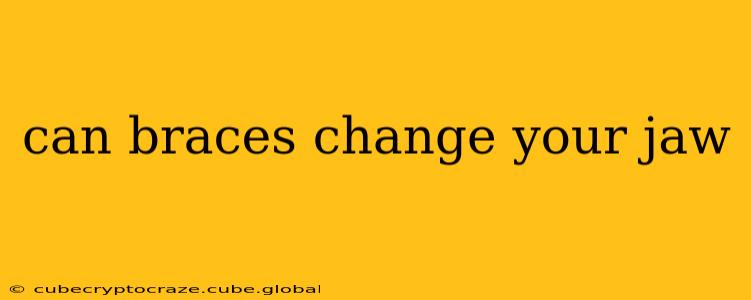Braces are primarily known for straightening teeth, but their impact extends beyond cosmetic improvements. Many wonder: can braces actually change the shape and position of your jaw? The answer is nuanced, depending on several factors, including your age, the type of orthodontic treatment, and the specific jaw issues present.
How Braces Can Affect Jaw Growth and Position
While braces can't dramatically reshape a fully developed jawbone, they can influence jaw growth and position, especially in younger patients. This influence is achieved through the application of gentle, consistent pressure over time. The movement occurs primarily through the remodeling of bone tissue, a process known as bone resorption and deposition.
Bone Resorption: This is the process where the bone dissolves and is reabsorbed by the body. Braces create this resorption on the side of the bone where the pressure is applied.
Bone Deposition: Conversely, on the opposite side of the applied pressure, bone deposition takes place – new bone tissue is formed to fill in the space.
This constant cycle of resorption and deposition, meticulously guided by orthodontic appliances, allows for gradual changes in jaw position. This is particularly effective during growth spurts in adolescence, when bone is more malleable.
Can Braces Correct an Overbite or Underbite?
Yes, braces can indeed correct certain jaw misalignments like overbites and underbites. These malocclusions are often associated with discrepancies in jaw growth and relationship. By carefully guiding tooth and jaw movement, orthodontists can improve the bite and facial aesthetics. However, the extent of correction depends on the severity of the malocclusion and the patient's age. Severe cases might require more extensive treatment, potentially including surgery in conjunction with braces.
What are the different types of orthodontic treatments for jaw misalignment?
Several orthodontic treatments can address jaw misalignment, each with varying degrees of invasiveness and effectiveness:
- Traditional braces: These are the most common and involve metal brackets and wires to move teeth and influence jaw position.
- Invisalign: These clear aligners are removable and gradually reposition teeth, which may indirectly influence jaw position in some cases. However, they are typically less effective than braces in addressing severe jaw issues.
- Headgear: This external appliance is used in conjunction with braces, primarily to control jaw growth and manage severe overbites or underbites.
- Surgery: In some severe cases of jaw misalignment, surgery may be necessary to correct skeletal discrepancies before or after orthodontic treatment.
How Effective are Braces in Shifting Your Jawline?
The effectiveness of braces in shifting your jawline is dependent on several crucial factors:
- Age: Younger patients, whose jaws are still growing, are more responsive to orthodontic treatment. Adults can still benefit from braces, but the extent of jaw movement is limited due to the fully developed bone structure.
- Severity of Misalignment: Minor jaw discrepancies are more easily corrected than severe malocclusions requiring more extensive treatment.
- Treatment Plan: A tailored treatment plan designed by an experienced orthodontist is crucial for achieving optimal results.
Can Braces Change the Shape of Your Face?
While braces primarily focus on teeth alignment and jaw position, indirect changes to facial appearance can occur. Improved bite alignment and jaw positioning can positively affect facial symmetry and profile. However, braces themselves do not fundamentally change the underlying bone structure of the face; the changes are primarily a result of subtle adjustments in jaw and tooth positioning.
Can Braces Move Your Jaw Forward?
Yes, in certain cases, braces can be used to move the jaw forward. This is often done to correct underbites or improve facial profile. However, this is usually a gradual process that occurs in conjunction with other orthodontic treatments.
Do Braces Affect Jawline Definition?
Braces don't directly define the jawline. Jawline definition is primarily determined by genetics and bone structure. However, improving the overall alignment of teeth and jaws can subtly enhance the facial aesthetic, creating a more defined appearance in some individuals. This is usually an indirect consequence of the treatment and not a direct effect of the braces themselves.
This information is for educational purposes only and does not constitute medical advice. Consult with a qualified orthodontist for personalized advice and treatment recommendations. Remember, a qualified professional can assess your individual situation and determine the most appropriate treatment plan to address your specific needs and concerns.
